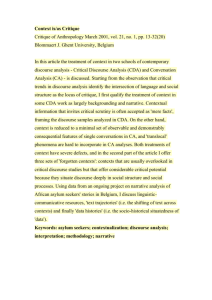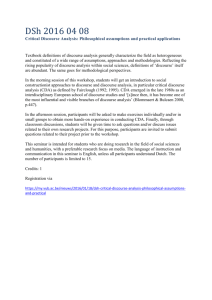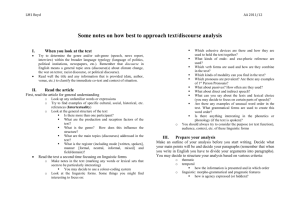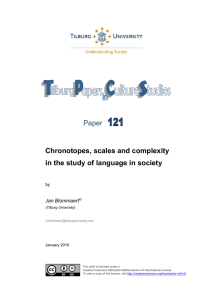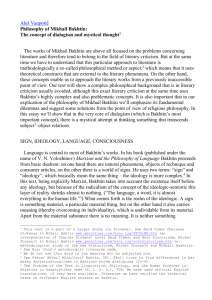this response
advertisement
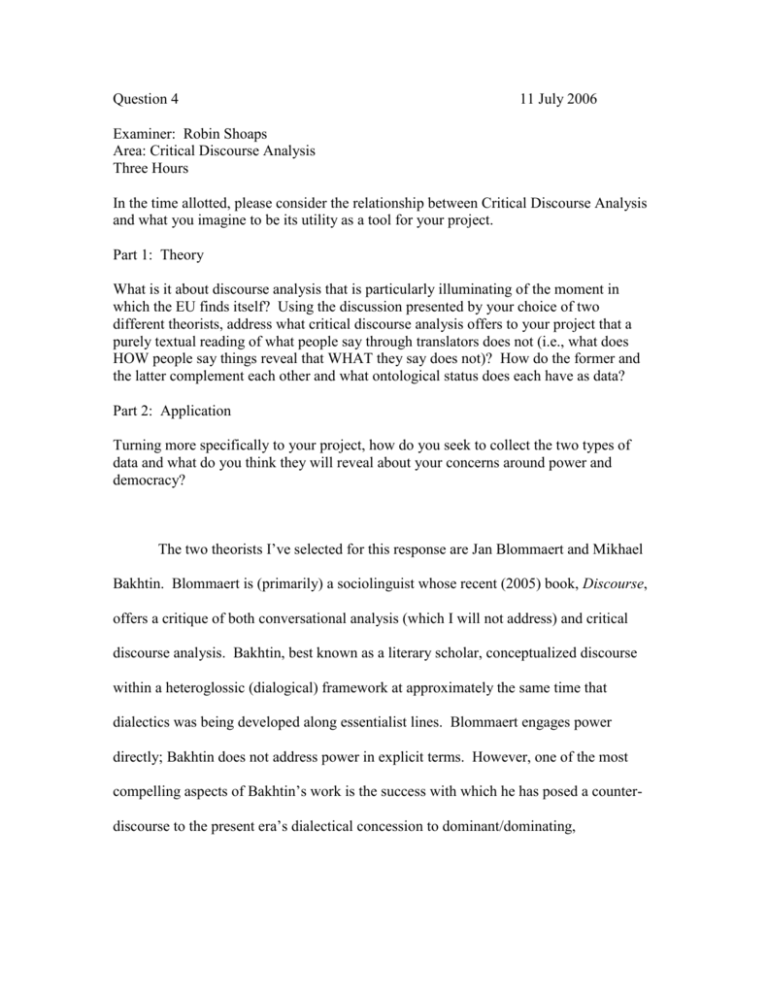
Question 4 11 July 2006 Examiner: Robin Shoaps Area: Critical Discourse Analysis Three Hours In the time allotted, please consider the relationship between Critical Discourse Analysis and what you imagine to be its utility as a tool for your project. Part 1: Theory What is it about discourse analysis that is particularly illuminating of the moment in which the EU finds itself? Using the discussion presented by your choice of two different theorists, address what critical discourse analysis offers to your project that a purely textual reading of what people say through translators does not (i.e., what does HOW people say things reveal that WHAT they say does not)? How do the former and the latter complement each other and what ontological status does each have as data? Part 2: Application Turning more specifically to your project, how do you seek to collect the two types of data and what do you think they will reveal about your concerns around power and democracy? The two theorists I’ve selected for this response are Jan Blommaert and Mikhael Bakhtin. Blommaert is (primarily) a sociolinguist whose recent (2005) book, Discourse, offers a critique of both conversational analysis (which I will not address) and critical discourse analysis. Bakhtin, best known as a literary scholar, conceptualized discourse within a heteroglossic (dialogical) framework at approximately the same time that dialectics was being developed along essentialist lines. Blommaert engages power directly; Bakhtin does not address power in explicit terms. However, one of the most compelling aspects of Bakhtin’s work is the success with which he has posed a counterdiscourse to the present era’s dialectical concession to dominant/dominating, 2 Foucauldian-type language regimes (here understood as discourses).1 Bakhtin has exercised power through his use of linguistic resources, those that Blommaert theorizes (and demonstrates) are inevitably distributed unequally among users in all societies and whose utility is in making one’s voice understood. Blommaert traces critical discourse analysis back through Norman Fairclough (among others) to Michael Halliday, explaining that Hallidayan linguistics were, in part, a reaction against the essentializing linguistics of Noam Chomsky. While not using Bakhtin’s terms, what Blommaert accomplishes is an outline of certain centripetal and centrifugal forces of language-in-action: there has been an on-going centripetal movement toward the foundational and figural significance of language-as-such (Benjamin) in the constant (re)production of meaning; and centrifugal moves away from a unitary, universalizing agreement about the ontological mechanisms that imbue language with such power. Blommaert refines the notion of language-in-use with its potentially passive implications to language-in-action in order to highlight the role of language – through discourse – in creating power regimes, generating inequalities, and maintaining the social structures that reproduce the regimes and the inequalities. Such a focus on the power effects of language-in-action is not to concede that language regimes always win. Both Blommaert and Bakhtin acknowledge the presence of constraints, boundaries, and borders for the expression of (what Bakhtin calls) “speech communication,” however what intrigues them both are the possibilities of heteroglossia (Bakhtin) and entextualization (Blommaert). These notions stem from the fact that there are “no monological utterances” (Bakhtin) and no “non-social discourse” (Blommaert). The term, “language regime,” is used in two different ways in this paper: in Foucault’s sense of regimes of power through language, and as a generic label for language policies/languages in use during simultaneous interpreting. 1 3 Both claim there is no such thing as a homogenous unitary “language” (e.g., “French,” “English,” “Bhutanese”) rather, there are language varieties which interact and layer among each other composing a complex of ‘a language.’ These notions illuminate the historical moment of the European Union in many significant ways. Having just expanded (in 2004) the language regime of the European Parliament from thirteen to twenty-five official languages – all requiring simultaneous interpretation at given times – the questions of WHAT language “is” and “does” and HOW language accomplishes its effects when uttered “directly” in the “same language” or “ indirectly” via an interpreter from “one language” to “another language” beg to be answered because the (non)answers are constitutive of the discourses, power effects, and social structures that the Parliament enacts and models to the rest of the EU (and the world). Bakhtin’s notion of speech genres is particularly relevant in this instance because of the opportunity to observe and document transitions in speech styles among Parliamentarians (officially called Members of Parliament, MPs). According to Bakhtin, style and genre are inseparable, and problems can arise when styles appropriate to one genre are transported to another genre. This is similar to Blommaert’s assertion that local uses of linguistic resources may fail to translate to other locations, such that (for instance) speakers who achieve understanding ‘at home’ (locally, in their own nation), i.e. – those who are effective at enacting voice – may fail to be equally effective in the polyglot milieu of the European Parliament with its own stylistic parameters (its own institutionalized genre). In short, MPs linguistic resources might not translate to a nonlocal site. 4 Enter simultaneous interpreters and the process of simultaneous interpretation. The European Union has invested a huge amount of rhetoric, political will, financial and educational structures, resources, and personnel to the notion of an encompassing democracy of autonomous nations predicated upon the fundamental right of language choice. While Blommaert’s overall conception of discourse explicitly includes more than the linguistic components of words and grammar (he argues that other semiotic signs often compose the “action” part of “language-in-action”), he would not disagree with Bakhtin’s assertion: “The utterance is a node of problems.” How is one to coordinate meaning when “the utterance” – the most fundamental component of speech communication – is uttered in different languages and translated (sometimes doubly so, from original author through a pivot interpreter to the interpreter of the target language) into – not just one language (a lingua franca) – but actually several more? Posing this question invokes ontological and methodological implications as well as practical and political ones. A purely textual analysis of what interpreters render of original speakers’ messages privileges the universalizing and essentializing Chomskian notion of a deep structure for meaning. It enables the isolation of utterances by encouraging a one-to-one comparative analysis: “Did you say what I said?” Such a framework denies the utterance recognition of its situatedness in a particular context and historical, discursive trajectory as well as ignores the actual communicative function of language – a function Bakhtin complains is often largely forgotten. The terms of Blommaert’s argument are different however the intent is basically the same: languagein-action cannot be understood outside of or apart from the backdrop of globalizing 5 forces emanating in and through social structures – and discourses about social structures – everywhere. A critical discourse analysis, as opposed to a strictly textual analysis, recognizes that every utterance – even those by interpreters – are (at least in part) a response to previous utterances. Bakhtin makes this point emphatically – it could be considered his nod to dialectics. Blommaert’s emphasis on linguistic resources provides a lens with which to explore interpreter’s execution of their own language plan for the interaction between author/addressee using their best intuition of the language plan of each author. Author, addressee, and language plan are Bakhtin’s terms. In other words, the interpreter’s goal (from the vantage point of a discourse analysis) is to contribute to the generation of understanding, to enhance the exercise of voice. In order to do this, interpreters insert themselves between authors and addressees and repackage the elements of the author’s utterance into what they consider will be the most readily receivable form for the addressee. Interpreters, in general, seek to promote centripetality in the discourse, even if the meaning which coheres is (as one interpreter from the EP explained) “the desire not to communicate!” In this regard, the distinction posed in this exam question between “what people say” and “how they say it” is not the focal point of what a critical discourse analysis of interpreted speech brings to the table. A critical discourse analysis brings into view the role of the interpreter as a linguistic resource and as a participant in the event/occurrence of speech communication. A purely textual analysis of what is interpreted reifies established notions of language as relatively fixed, minimizing the relational (i.e., communicative) elements and sidestepping issues of linguistic inequality. This is not to 6 diminish the importance of comparative work between original and interpreted speech but it is to put it in its proper place as only one aspect of “the whole of the utterance” and as just one “link in the chain of speech communication” (Bakhtin). What is interesting about how these two modes of analysis relate to each other is the way in which they play out ongoing tensions between spoken and written languagein-action, between “the utterance” and “the sentence.” Interpreters are explicitly trained to speak in “sentences” not “utterances.” Bakhtin bemoaned the lack of an adequate theory of the utterance (a task I do not choose to take up) – which may be one reason why interpreters are so instructed. Since the explicit task of the European Parliament is to participate in the process of crafting law, the written text appears to take primacy over the spoken discourse: one may speculate that the interpreted utterance takes precedence over the original utterance. This relates to Blommaert’s discussion of the trajectories of discourse and consequent power effects. In order to generate language-in-action that is picked up and carried into other forms, discourses, and effects, one must exercise sufficient voice in spoken discourse. A textual analysis can trace these trajectories. Theoretically, what putting the two modes of textual and discourse analysis sideby-side within a framework of language as constitutively heterogeneous, polyphonic, diglossic and dialogic brings into view is Benjamin’s notion of language-as-such. If there are no such things as universal, fixed, essential languages, then there really is only one human language spread out along a continuum of varying degrees of difference. Varieties of particular languages (dialects, say) might compose one of the smaller degrees of difference (with individual idiosyncracies the smallest – Bakhtin states everyone has “their own language”), while the blatant differences between national languages, or even 7 families of languages (e.g., Germanic vs Persian) are degrees of the largest kind. The experiment of the European Parliament regards the extent to which its speech genre (as a governing and modeling institution) regards these differences as significant, meaningful and fundamental as differences. Which brings us to application. My concerns around power and democracy are perhaps better understood as concerns with inequality and social justice. I agree with Blommaert that power is not bad and I hope to emulate Bakhtin’s mode of exercising it. I admire the vision and ambition of the Europeanists and respect the skill and dedication of the interpreters who work for EU institutions. Nonetheless, there are gaps and inconsistencies in the rhetoric of the vision of (in short) “language choice = democracy” and the implementation of its practice. Centripetal forces work within the European Parliament to minimize the language regime (here understood as the number of languages in use/being interpreted) and thus reinforce existing linguistic inequalities along historic diacritic lines. The fact of language difference is, in and of itself, a centrifugal force that resists not only monolingualism but also – and more importantly – a monologic. I imagine that the utility of critical discourse analysis as a tool for studying these forces of language in the European Parliament’s practices of simultaneous interpretation will bring into view more precisely the operation of these forces at the so-called purely textual level. I think that exposing these forces will reveal the importance of acknowledging the constraints of one’s own linguistic resources and inspire more discussion about the practical, functional, and communicative importance of interpreters as links in a continual chain of responsive and responding utterances working to minimize power effects leading to inequalities. I will collect data in the traditional 8 ethnographic ways, via participant observation and interviews with all parties (as many as possible) and keep my own learning and discovery process open and available (as data about the trajectory of knowledge construction) to those who wish to stay informed. The European Parliament provides an elaborate social Petri dish for the exploration of the power effects of language, heteroglossia, and the exercise of voice. This moment is historic for Europe, but also representative of global transnational trends. I hope that what I am able to construct from research there, using critical discourse analysis as my primary tool, will provide a basis for more research and substantive policy-making regarding the provision of simultaneous interpreting for more persons displaced (by choice or force) by transnational flows.



